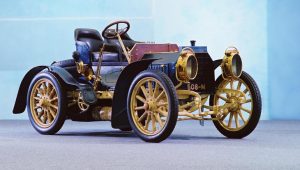
Naturally, Maybach and DMG were more than happy about the success of the 35 hp car and its lasting appreciation by buyers, automotive experts and the public at large. As early as March 1901, the product range was extended by the addition of the smaller 12/16 hp Mercedes and in August by a third model, the 8/11 hp Mercedes. Maybach began further developing the first Mercedes series in the fall of 1901 already. To start with, the 40 hp Mercedes-Simplex was designed as a new top model and direct successor to the 35 hp Mercedes. Its wheelbase was extended to 2450 millimeters, its operation made easier by the “automatic” declutching and deceleration of the drive shaft upon actuation of the shift lever. The improvement of operational comfort at this early stage is reflected by the model’s epithet, “Simplex”.
While the engine’s external dimensions remained unchanged, bore and stroke were modified, raising displacement to 6786 cc and output to 40 hp. The camshafts were encapsulated and a single carburetor was installed with a new pre-heating unit which improved the atomizing effect of Maybach’s air nozzle.
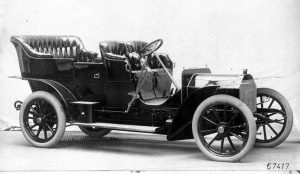
The cooling was also improved in that the flywheel – a fairly large unit with a diameter of 60 centimeters – was fitted with guide vanes for increasing the air flow through the radiator and engine compartment. The radiator fan was omitted, the engine compartment fitted with covers and baffle plates, the underside of the car closed by means of sheet metal panels – an idea that had an inspiring effect on subsequent engine designs throughout the world. The coolant capacity required dropped by another two to seven liters.
To match the further increased engine output, the car was fitted with a second foot-operated brake – a band brake acting on the intermediate shaft of the chain drive. All four brakes – the rear wheel drum brakes and the existing foot-operated brake – were cooled by means of splash water that dripped onto the friction surfaces from a reservoir when the brakes were applied.
Additional design modifications brought the Mercedes-Simplex’ weight down to 942 kilograms, giving the car excellent prospects of winning races against its clearly heavier competitors. The first of these epoch-making models was shipped to Emil Jellinek in Nice on March 1, 1902. The new model scored success in the Nice race week right from the start – like the 35 hp Mercedes a year earlier, the 40 hp car won the hill climb race from Nice to La Turbie in record time. It scored success right from the start and became the ancestor of all subsequent generations of Mercedes racing and sports cars. The Mercedes-Simplex became the talk of the town and inspired no lesser person than Emperor Wilhelm II to come up with a bon mot. At the Berlin motor show in March 1903, he told Wilhelm Maybach: “A truly beautiful engine you have here! But it’s not as simplex as that, you know.”
The 40 hp Mercedes-Simplex of William K. Vanderbilt Jr.
On March 14, 1902, the fifth 40 hp Mercedes-Simplex was handed over by DMG in Cannstatt to William K. Vanderbilt Jr., an American billionaire and car enthusiast who already owned a 35 hp Mercedes. He started out straightaway on a 600 kilometer trip to Paris where he arrived on the evening of the next day. On May 3, he successfully established a speed record over one kilometer with a flying start on the road between Ablis and Chartres: his Mercedes-Simplex reached a top speed of 111.8 kilometers per hour.
Participation in long-distance races – popular events at the time – and repeated record runs in Europe and America were a sporting pastime for Vanderbilt Jr. Besides, these events consolidated the legendary reputation of the Mercedes – and its driver – and provided DMG with a growing number of prominent customers. The 40 hp Mercedes-Simplex of William K. Vanderbilt Jr., model year 1902, is by all accounts the oldest existing Mercedes and one of the few surviving cars from this model series. Its history can be traced back completely. It was bought in 1923 by a German race car mechanic who had emigrated to America and ran a Mercedes workshop. “Mercedes Joe” first and foremost serviced the cars of movie stars, using his Simplex as a replacement part carrier. In 1930, the car was sold to the Scripps family, rich newspaper publishers from San Diego. Well worn but indestructible, the Simplex served as a learners’ car for the Scripps family’s children until the early forties. It was then transferred to the family farm where it was eventually parked for good in a barn. In 1960, the Scripps family sold the car to Bill Evans Sr. who displayed it in his Bahia Hotel, built in 1953, in San Diego. His research revealed that he had indeed acquired a 1902 model. Reliable proof is provided by the front axle made of a single tube and the leaf springs which were flexibly suspended on the front end of the frame only on this 1902 model. Today Vanderbilt’s 40 hp Mercedes still boasts impressive performance and turns no fewer heads than it did in March 1902.

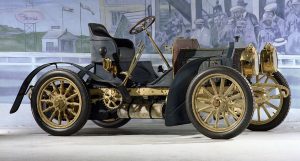
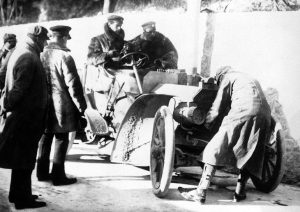
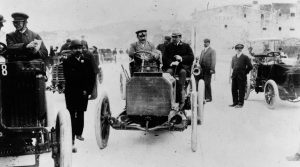

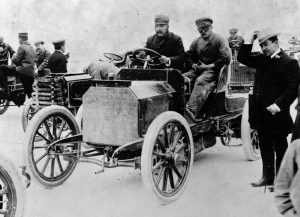
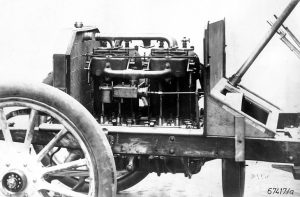
You must be logged in to post a comment.